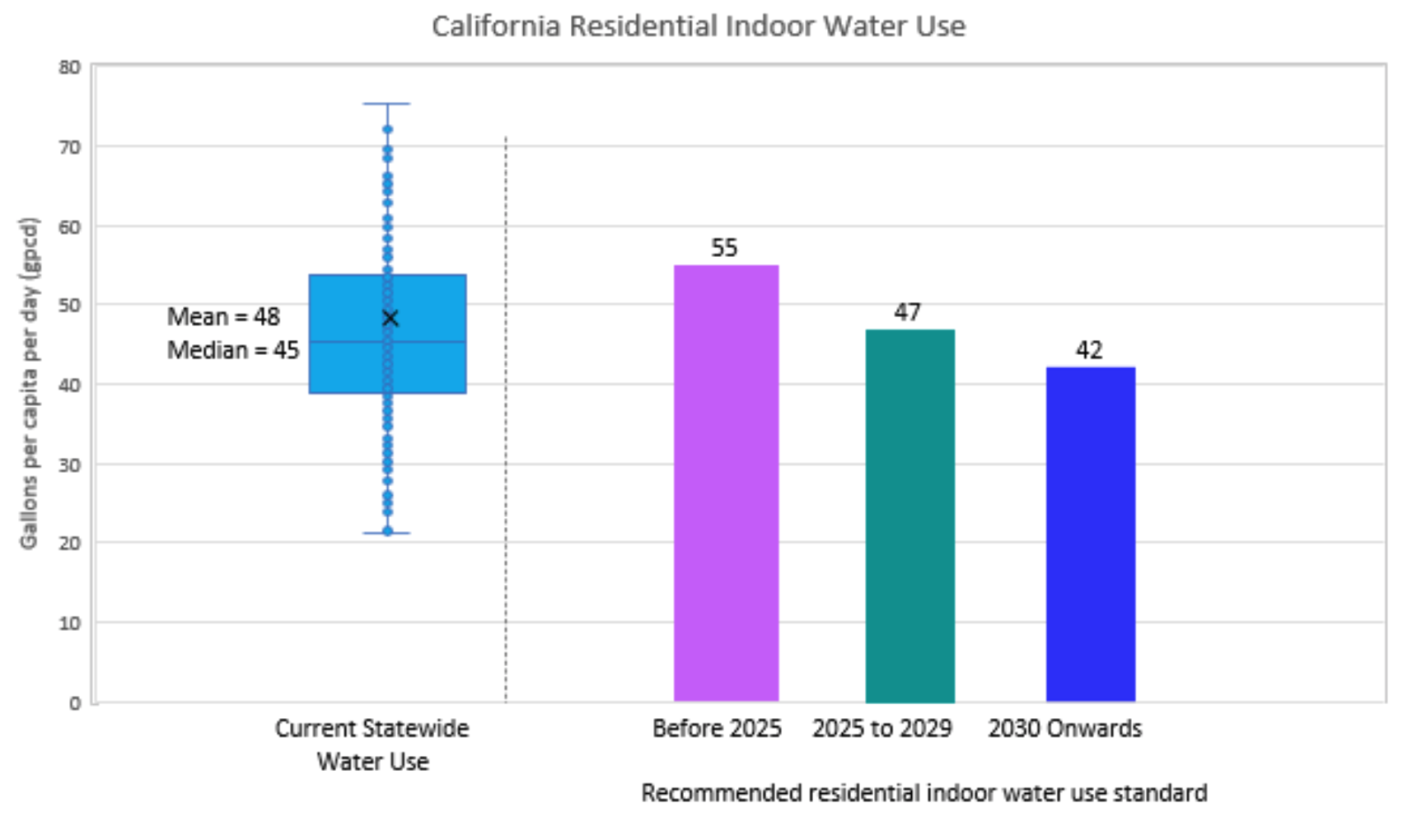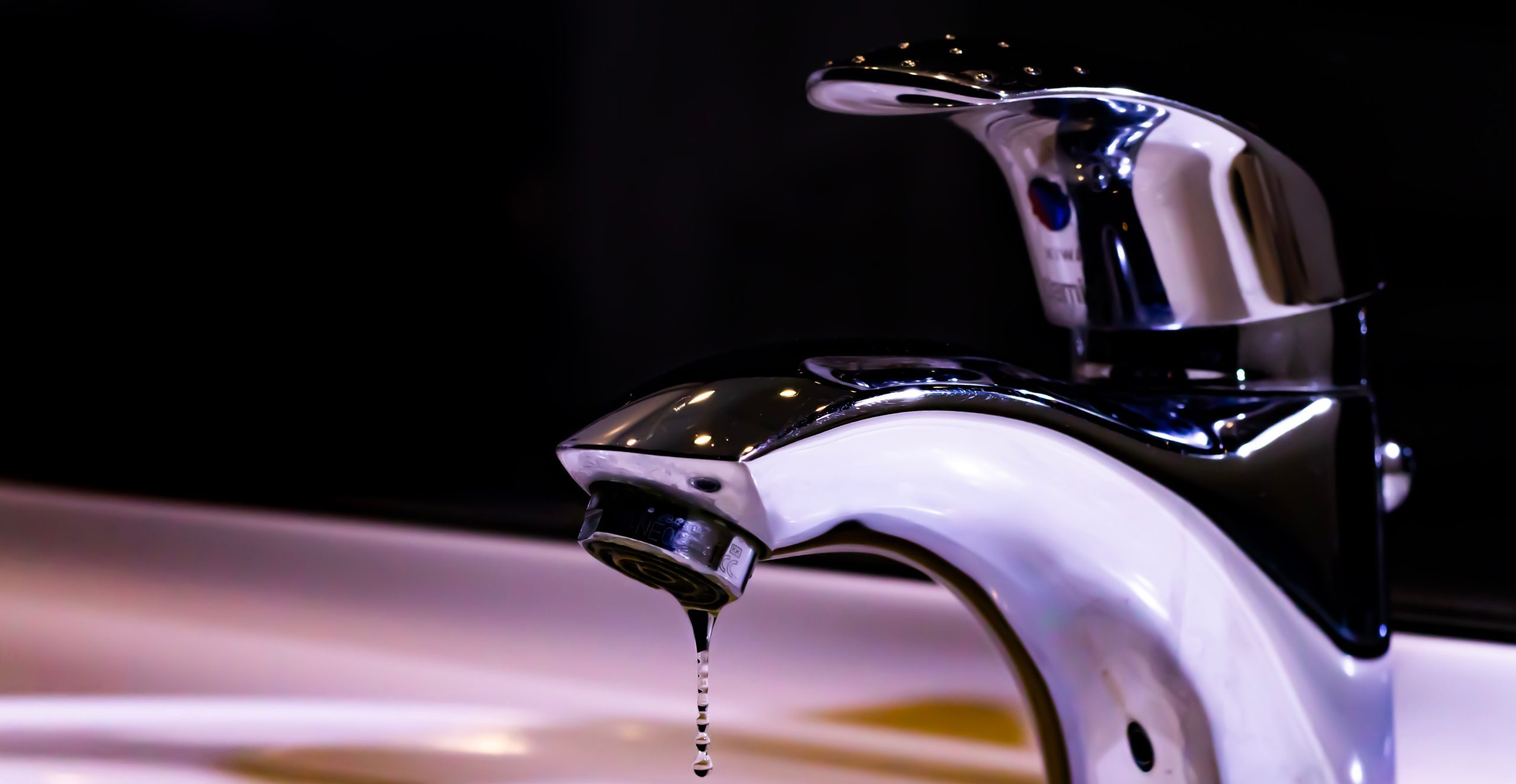By Cora Kammeyer, Sonali Abraham, and Heather Cooley
Key Takeaways
- Per 2018 legislation, California State agencies are developing water use standards for all urban water suppliers in the state.
- In November, the California Department of Water Resources and State Water Resources Control Board issued recommended standards to the legislature for residential indoor water use.
- Pacific Institute analysis shows most urban water suppliers are already below the recommended 2025 residential indoor water use standard.
- It is critical that California adopt strong, forward-looking water use standards given the current drought and climate crises.
After record-breaking drought conditions in 2021, California is looking at another bleak water year in 2022. Despite the mid-December precipitation, over 90% of the state is still in severe drought, and the California Department of Water Resources (DWR) announced an initial 0% State Water Project allocation for the first time ever. In October, California Governor Gavin Newsom declared a statewide drought emergency and urged a voluntary 15% reduction in water use for California cities. So far, most areas are falling short of the target, and mandatory cutbacks are likely for next year.
In November, amid the deepening drought, the DWR and the State Water Resources Control Board (SWRCB) issued joint recommendations to the California State Legislature for new indoor residential water use standards, along with a study supporting the recommendations (hereafter the Indoor Residential Water Use Study, or IRWUS).
Background on Urban Water Efficiency Legislation
As background, in 2018, the California legislature passed and Governor Brown signed Assembly Bill 1668 (Friedman) and Senate Bill 606 (Hertzberg). This bill created a new framework for setting customized water use targets for urban water suppliers in California.
In AB 1668 and SB 606, the State of California made a commitment to use the best available data and information to set water efficiency standards for urban water suppliers. When the bills were passed, limited data were available on indoor water use and 55 gallons per capita daily (gpcd) was selected as a placeholder for the residential indoor standard. The legislation directed the state agencies to conduct necessary studies and jointly recommend a standard by 2021 that reflects current best practices.
New Urban Indoor Residential Standards
Using four detailed analytical approaches, the IRWUS estimated that statewide indoor water use averaged 48 gpcd between 2017 and 2019, well below the 55 gpcd placeholder standard. Indoor water use is expected to decline because of plumbing codes, appliance and fixture turnover, and new housing – so called “passive conservation.” The IRWUS projected that median and average indoor water use would decline to about 44 gpcd by 2030 without any active conservation efforts. Based on the study’s findings, the agencies jointly recommend that the indoor residential standard remain at 55 gpcd through 2024 and decline to 47 gpcd in 2025 and to 42 gpcd starting in 2030.
Active conservation – like utility rebates, conservation-oriented rate structures, and education programs – can provide additional water savings, though the IRWUS did not attempt to quantify the active conservation potential.
Indoor Residential Water Use in California
The Pacific Institute analyzed data reported by water suppliers in their Electronic Annual Reports (EARs) for 2017 through 2019 to get a sense of how water suppliers would stack up with the new standards. The EAR is an annual survey of public water systems that collects water-system information, including water use by sector. The EAR does not contain estimates of indoor water use, as this is not measured directly; however, indoor use can be inferred from these data using a methodology validated by DWR in the IRWUS.
Figure 1 shows current indoor residential water use and the recommended water use standards. Current residential indoor use is shown as a box-and-whisker plot. Between 2017 and 2019, indoor residential water use averaged 48 gpcd (shown as an ‘X’ in the blue box), with a median value of 45 gpcd (shown as the dotted line near the middle of the blue box). For 75% of water suppliers, indoor water was 54 gpcd or less (as indicated by the top of the blue box). For 25% of water suppliers, it was 39 gpcd or less between 2017 and 2019 (as indicated by the bottom of the blue box). The upper and lower ‘whiskers’ point to the upper and lower extremes in the data.
These data show that 78% of water suppliers were already below the current indoor standard of 55 gpcd between 2017 and 2019. Likewise, 56% of suppliers were below the 2025 standard of 47 gpcd, and 37% were below the 2030 standard of 42 gpcd.

*Note: Outliers that were “outside of the whiskers” are not shown in the figure.
Establishing Forward-Looking Urban Water Use Standards
The indoor standard is the first in a series of urban water use standards that will be submitted in 2022 in adherence with the 2018 legislation, “Making Water Conservation A California Way of Life.” Recommendations for water use standards on residential landscapes, large commercial landscapes, and water loss will follow the indoor standard during the coming months. While the indoor standard will be considered and adopted by the legislature, the remaining standards will be considered, revised as needed, and adopted by the SWRCB. Together, these standards will establish water budgets for every urban water agency in California. Regulations require that every urban water supplier meets their water budget, but there is flexibility in how to achieve it. For example, a water supplier can exceed the indoor standard as long as the total water use objective is met.
It is vital that the State adopt strong, forward-looking standards to ensure greater levels of water efficiency and conservation given the current drought and climate crises facing California. We will face more severe droughts and hotter temperatures in the years to come, putting greater pressure on water resources. Robust water efficiency standards will help ensure that the state’s drinking water supplies are available for essential uses, and not wasted. This is true not just for California, but also for the Western U.S. and many other arid regions around the world. In the face of increasing drought frequency and intensity in these places, water efficiency is the most cost-effective source of “new” water supply, and is critical tool for building long-term water resilience.
For more information about the California drought and California cities’ water use, visit www.californiadrought.org. To read more of the Pacific Institute’s work on water efficiency, visit www.pacinst.org/water-efficiency-and-reuse.



NOW California bureaucrats need to be sued to keep them from releasing stored water for humans into the ocean.